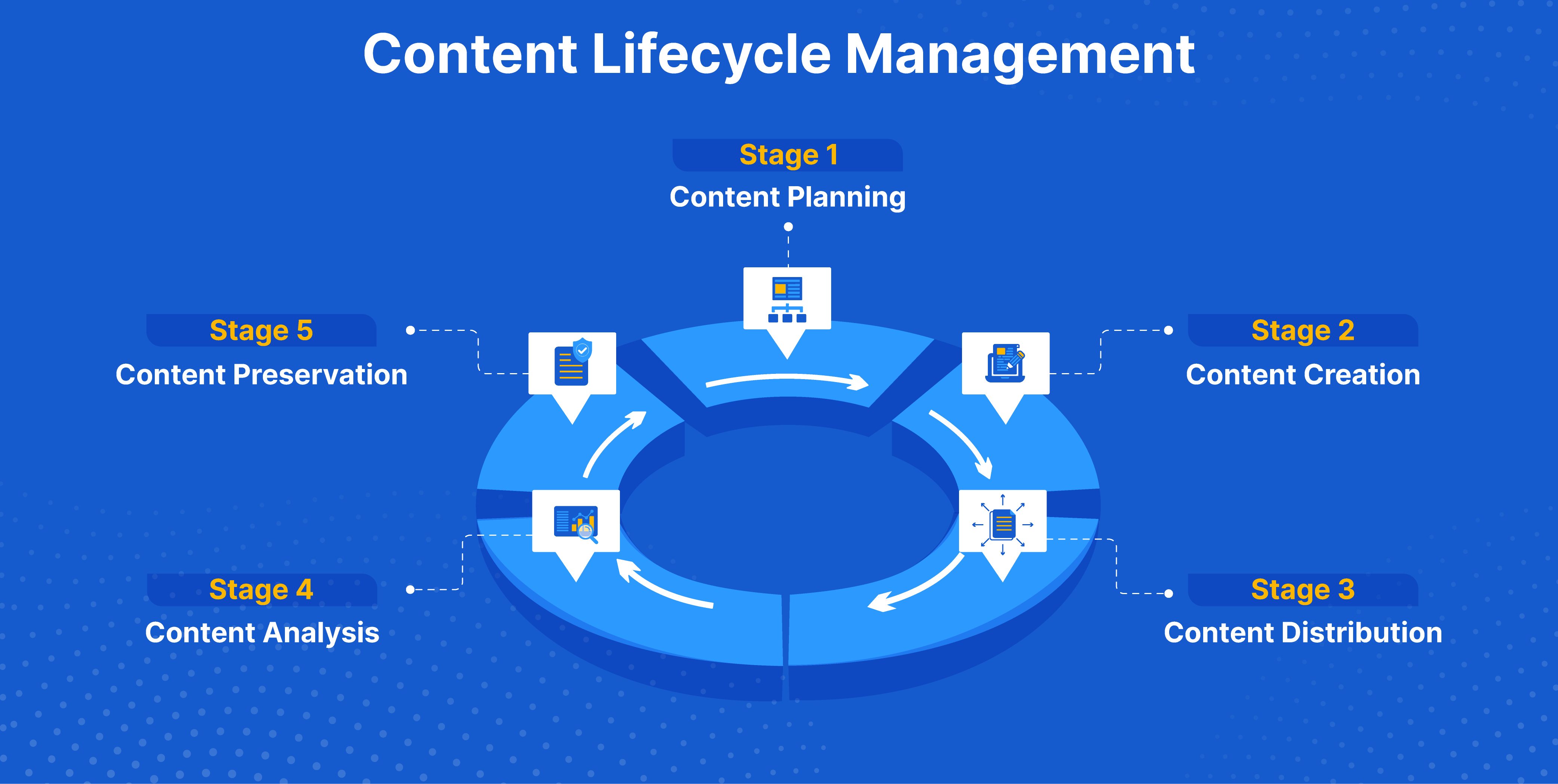How Content Lifecycle Management Works: A Comprehensive Guide
- 1 Detail Guide On Content Lifecycle Management Working
- 1.1 Planning: Laying the Foundation for Success
- 1.2 Creation: Where Ideas Come to Life
- 1.3 Review: Quality Assurance and Fine-Tuning
- 1.4 Publication: Releasing Content Into the Wild
- 1.5 Maintenance: Keeping Content Fresh and Relevant
- 1.6 Promotion: Amplifying Your Content’s Reach
- 1.7 Archiving: The End is a New Beginning
- 2 How These Additional Stages Complete the Cycle
You’re buzzing with content ideas, scribbling notes, and eager to engage your audience. Yet, in today’s crowded digital landscape, the act of producing content isn’t just about writing a few blog posts and hitting ‘publish.’ It’s an intricate process with multiple moving parts, all working in tandem to achieve a common goal: connecting with your audience meaningfully. Welcome to the world of content lifecycle management, where strategies, technologies, and best practices come together to create an efficient, effective content machine.
Understanding the content lifecycle management process can revolutionize how you handle everything from idea generation to distribution. Forget shooting in the dark and hoping for the best; with a structured approach, you can create more targeted, relevant, and impactful content. Stick with me, and by the end of this guide, you’ll have a comprehensive understanding of the steps involved, how to make the most out of each, and why this all matters.
Detail Guide On Content Lifecycle Management Working
Planning: Laying the Foundation for Success
In the planning stage, you’re laying down the blueprints for your entire content strategy. Think of this as creating a map that guides you toward your ultimate destination: reaching and engaging your target audience. You must conduct market research, set objectives, identify the target audience, and finalize content types, formats, and channels. A well-defined editorial calendar is the cornerstone of this phase, ensuring you cover relevant topics while staying ahead of the curve.
Creation: Where Ideas Come to Life
In the creation phase, you roll up your sleeves and get to work. Your initial planning gives you a roadmap, but now it’s time to create the actual content. In this stage, you unleash your creativity, putting words on paper, designing visuals, or shooting videos. Content creation is often the most time-consuming step but also the most rewarding. Use tools like content management systems (CMS), graphic design software, and video editing platforms to streamline this stage. Remember, the quality of your content is crucial here; it will make your audience stop scrolling and pay attention.
Review: Quality Assurance and Fine-Tuning
Once you’ve put together your piece, it’s not ready for the world to see just yet. The review phase involves rigorous quality checks to ensure your content meets your brand standards and objectives. Grammar checks, visual coherence, relevance, and factual accuracy are some of the elements that need verification. This stage often involves multiple stakeholders, including editors, brand managers, and even legal teams for compliance. Automated proofreading tools and collaborative platforms can make the review process faster and more efficient.
Once the content passes through the review process, it’s time to hit the ‘publish’ button. But that’s not all. Proper scheduling, cross-channel distribution, and audience targeting are essential to ensure your content reaches the right people at the right time. Omnichannel content management plays a crucial role here, allowing you to seamlessly distribute your content across various platforms while maintaining a consistent brand voice and message. Use tools like social media schedulers, email marketing software, and analytics platforms to monitor how your content is performing in real time.
Publication: Releasing Content Into the Wild
The moment of truth has arrived. Once the content passes through the review process, it’s time to hit the ‘publish’ button. But that’s not all. Proper scheduling, cross-channel distribution, and audience targeting are essential to ensure your content reaches the right people at the right time. Use tools like social media schedulers, email marketing software, and analytics platforms to monitor how your content is performing in real time.
Maintenance: Keeping Content Fresh and Relevant
The lifecycle of content doesn’t end at publication. The digital world is always changing, and your content needs to keep up. Regularly update your articles, blog posts, or content assets to maintain relevance. This also includes revisiting your content to analyze its performance metrics. Data on user engagement, conversion rates, and ROI are pivotal for adapting your future content strategy. Automated analytics tools can provide insights to fine-tune your content for better results.
Promotion: Amplifying Your Content’s Reach
So you’ve hit the ‘publish’ button. Great! But if you think your work is done, you’re missing out on a crucial step: promotion. If your content is extraordinary, it might go viral organically, but relying solely on organic reach is risky. The promotion stage involves strategies like social media advertising, influencer partnerships, SEO optimization, and email campaigns to extend the reach of your content. This is where you strategically ‘push’ your content toward your audience rather than waiting for them to ‘pull’ it in by stumbling across it. Successful promotion increases visibility and drives engagement, making this stage as important as any of the others. Utilize analytics tools to measure the success of your promotional tactics so you know what’s working and what needs fine-tuning.
Archiving: The End is a New Beginning
Contrary to popular belief, content does have a shelf life. Trends change, technologies evolve, and what’s relevant today might not be tomorrow. So, what happens to your content when it’s past its prime? That’s where archiving comes in. Archiving isn’t merely deleting old content; it’s about preserving it for potential future use or reference. Assess your content periodically to identify outdated pieces that no longer align with your brand’s message. Move these to your archive, but keep them accessible. You never know when old data offer new insights or past content could be revamped and repurposed. Just like composting can turn waste into nutrient-rich soil; archiving can help transform ‘expired’ content into future gold.
How These Additional Stages Complete the Cycle
Adding promotion and archiving brings a more rounded, holistic view to content lifecycle management. Promotion ensures that your carefully crafted content reaches the maximum number of eyeballs, making all the preceding work worthwhile. On the other hand, archiving cleanses your active content pool, keeping it fresh and up-to-date while preserving the old for potential future utility. These two stages make the cycle more efficient and responsive to the fast-paced changes in the digital content landscape.
Wrapping It Up: The Cycle Never Ends
Content lifecycle management isn’t a one-and-done process; it’s cyclical. With every iteration, you get more insights and improve your work. So start planning your next masterpiece with these stages in mind. Whether you’re a content novice or a seasoned pro, understanding the lifecycle of content management will equip you with the tools and knowledge to create compelling, impactful content consistently.

















